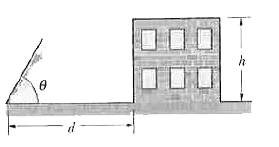A ball is shot from the ground into the air. At the height of 9.1 m, its velocity is v=(7.6m/s)ˆi+(6.1m/s)ˆj, withˆi horizontal and j upward. (a) To what maximum height does the ball rise? (b) What total horizontal distance does the ball travel? What are the (c) magnitude and (d) angle (below the horizontal) of the ball's velocity just before it hits the ground?
We designate the given velocity v=(7.6m/s)ˆi+(6.1m/s)ˆj as →v1 , as opposed to the velocity when it reaches the max height, →v2 or the velocity when it returns to the ground →v3, and take y, as the launch velocity, →v0 as usual. The origin is at its launch point on the ground.
Different approaches are available , but since it will be be useful (for the rest of the problem ) to first find the initial y velocity , that is how we will proceed . using eq. we have .
v_(1y)2=(v0y)2−2gΔy
substituting values , we have
(6.1m/s)2=v20y−2(9.8m/s2)(9.1m)
Which yields v0y=14.7m/s . Knowing that v2y must equal 0 , we use eq. again but now with Δy=h for the maximum height :
v22y=v20y−2gh⇒0=(14.7m/s)2−2(9.8m/s2)h
which yield h = 11 m
(b) Recalling the derivation of eq. but using v0y for v0sinθ0 and v0xcosθ0 we have .
0=v0yt−12gt2,R=v0xt
Which leads toR=2v0xv0ylg . noting that v0x=v1x=7.6m/s , we plug in values and obtain
R=2(7.6m/s)(14.7m/s)(9.8m/s2)=23m
(c ) since v3x=v1x=7.6m/s and v3y=−v0y=−14.7m/s , we have
v3=√v23x+v23y=√(7.6m/s)2+(−14.7m/s)2=17m/s
(d) The angle (measured from horizontal for →v3 is one of these possibilities :
tan−1(−14.7m7.6m)=−63∘or117∘
Topper's Solved these Questions
- MOTION IN TWO AND THREE DIMENSIONSBOOK - RESNICK AND HALLIDAYCHAPTER - MOTION IN TWO AND THREE DIMENSIONSEXERCISE - CHECKPOINT
3 Videos
- MOTION IN TWO AND THREE DIMENSIONSBOOK - RESNICK AND HALLIDAYCHAPTER - MOTION IN TWO AND THREE DIMENSIONSEXERCISE - PROBLEMS
50 Videos
- MOTION ALONG A STRAIGHT LINEBOOK - RESNICK AND HALLIDAYCHAPTER - MOTION ALONG A STRAIGHT LINEEXERCISE - PRACTICE QUESTIONS ( Integer Type )
3 Videos
- OSCILLATIONSBOOK - RESNICK AND HALLIDAYCHAPTER - OSCILLATIONSEXERCISE - Practice Questions
57 Videos
Similar Questions
A golfer hits a golf ball into the air over level ground. The velocity of the ball at a height of 10.3 m is →v=(8.6ˆi+7.2ˆj)m/s, with ˆi horizontal and ˆj upward. Find (a) the maximum height of the ball and (b) the total horizontal distance traveled by the ball. What are the ( c) magnitude and (d) angle (below the horizonatl) of the balls velocity just before it touches the ground?
View SolutionA ball is shot from the ground into the air. At a height of 9.1 m, its velocity is observed to be v=7.6ˆi+6.1ˆj in metre per second (ˆi is horizontal, ˆj is upward). Give the approximate answers.
(a) To what maximum height does the ball rise?
(b) What total horizontal distance does the ball travel?
(c) What are the magnitude and
(d) What are the direction of the ball's velocity just before it hits the ground?
View Solution
Knowledge Check
A ball is projected from the ground at angle θ with the horizontal. After 1s, it is moving at angle 45∘ with the horizontal and after 2s it is moving horizontally. What is the velocity of projection of the ball ?
A10√3ms−1B20√3ms−1C10√5ms−1D20√2ms−1
A ball is shot from the ground into the air. At a height of 9.1 m, its velocity is observed to be v=7.6ˆi+6.1ˆj in metre per second (ˆi is horizontal, ˆj is upward). Give the approximate answers.
(a) To what maximum height does the ball rise?
(b) What total horizontal distance does the ball travel?
(c) What are the magnitude and
(d) What are the direction of the ball's velocity just before it hits the ground?
View SolutionA baseball is hit at a height h = 1.00 m and then caught at the same height. It travels alongside a wall, moving up past the top of the wall 1.00 s after it is hit and then down past the top of the wall. 4.00 s later, at distance D = 50.0 m farther along the wall. (a) What horizontal distance is traveled by the ball from hit to catch? What are the (b) magnitude and ( c) angle (relative to the horizontal) of the ball's velocity just after being hit? (d) How high is the wall?

View SolutionA ball is thrown from the ground into air. AT a height of 9.0m, the velcoity is obsecred ot be →v=7.0ˆi+6.0ˆj. Find the masimum hight to which the ball will rise. g=10,s−2.
View SolutionA boy throws a ball with a velocity of 15 m/s at an angle of 15° with the horizontal. The distance at which the ball strikes the ground is
View SolutionIn a ball is thrown leftward from the left edge of the roof, at height h above the ground. The ball hits the ground 1.50 s later, at distance d = 25.0 m from the building and at angle θ=60.0∘ with the horizontal. (a) Find h. (Hint: One way is to reverse the motion, as if on video.) What are the (b) magnitude and ( c) angle relative to the horizontal of the velocity at which the ball is thrown? (d) Is the angle above or below the horizontal?

View SolutionA ball is projected from the ground at angle θ with the horizontal. After 1s, it is moving at angle 45∘ with the horizontal and after 2s it is moving horizontally. What is the velocity of projection of the ball ?
View SolutionA ball is kicked at an angle of 30∘ with the vertical. If the horizontal component of its velocity is 19.6ms−1, find the maximum height and horizontal range.
View Solution
